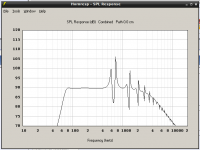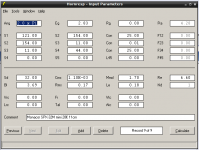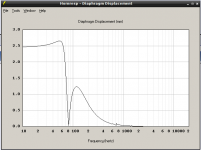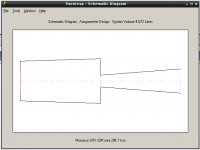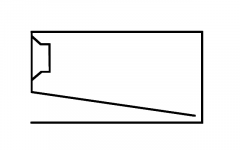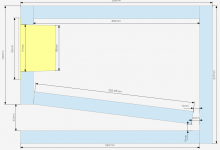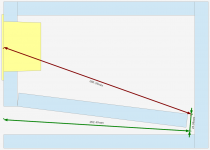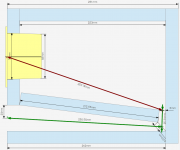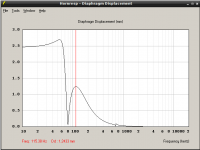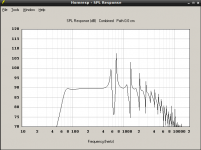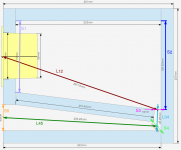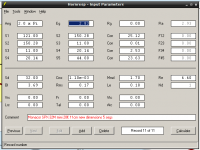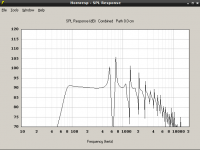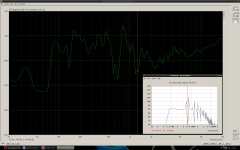Greetings!
I recently saw an offering for a Monacor SPX-32M MONACOR INTERNATIONAL : Product Detail Page which looks really interesting! Optically as well.
So I thought I'd give it a try and made up the following enclosure for the driver, This is my first attempt at designing a (high-end) speaker so any input is welcome!
The front face where the speaker is mounted is S1, the Wall on the opposite side S2, the beginning of the horn S3 and exit S4.
Height: 15cm Length: 25cm Width: 11cm
cheers!
hurtz
I recently saw an offering for a Monacor SPX-32M MONACOR INTERNATIONAL : Product Detail Page which looks really interesting! Optically as well.
So I thought I'd give it a try and made up the following enclosure for the driver, This is my first attempt at designing a (high-end) speaker so any input is welcome!
The front face where the speaker is mounted is S1, the Wall on the opposite side S2, the beginning of the horn S3 and exit S4.
Height: 15cm Length: 25cm Width: 11cm
cheers!
hurtz
Attachments
I'm a bit worried about the spikes in the output starting at 5kHz, but as I simulated other speakers they will always occur when using BR or similar. Will those spikes vanish with stuffing? Or are they just a "perfect physics" artefact in the first place and will never be reproduced that way?
cheers,
hurtz
cheers,
hurtz
a real life br enclosures should not have those spikes. the rear volume + duct acts like a lowpass filter. over 100hz or so, its only the front cones response.
Thanks for the reply + explanation MaVo!
I have now made a (technical) drawing of the speaker, once with dimensions, and the other one with the distances. With 19mm MDF.
The green lines are L34.
And the red lines are L12, but I'm not sure if this is the accurate way of modelling it. Should the distance be taken from the cone-center to the horn-center?
Or rather cone-center to opposite wall-center? I think it might be correct the way I did it, but it would be great if someone could check/explain why or why not.
cheers!
hurtz
P.s. These pictures are SO reminding me of those floating skulls from "Bubble Bobble"...
I have now made a (technical) drawing of the speaker, once with dimensions, and the other one with the distances. With 19mm MDF.
The green lines are L34.
And the red lines are L12, but I'm not sure if this is the accurate way of modelling it. Should the distance be taken from the cone-center to the horn-center?
Or rather cone-center to opposite wall-center? I think it might be correct the way I did it, but it would be great if someone could check/explain why or why not.
cheers!
hurtz
P.s. These pictures are SO reminding me of those floating skulls from "Bubble Bobble"...
Attachments
Last edited:
I like the box!
Maybe i will try to sim the Alpair 10.2 in this when i get home 😛 Directional is good
Maybe i will try to sim the Alpair 10.2 in this when i get home 😛 Directional is good

Thanks 🙂
I did a quick sim of the Alpair and I found that it needs a bigger box about 17l.. but that was just playing around.
Here are the updated dimensions and Hornresp response.
Total volume of the box is 4.1l
f3 = 68Hz
I have a question about cone excursion though, Hornresp tells me that with an input power of 1W into 8Ohm I will get a cone excursion of about 1.24mm at 115Hz. The speaker can handle only 1.1mm, so will I destroy the speaker at 1W ouput of my amp already?
cheers,
hurtz!
I did a quick sim of the Alpair and I found that it needs a bigger box about 17l.. but that was just playing around.
Here are the updated dimensions and Hornresp response.
Total volume of the box is 4.1l
f3 = 68Hz
I have a question about cone excursion though, Hornresp tells me that with an input power of 1W into 8Ohm I will get a cone excursion of about 1.24mm at 115Hz. The speaker can handle only 1.1mm, so will I destroy the speaker at 1W ouput of my amp already?
cheers,
hurtz!
Attachments
I honestly do not know.
But the hornresp simulations I have ended up building show that in all cases the hornresp prediction of xmax is far higher than the real one. But I can not answer for your simulation, it may end up being a realistic value.
I suggest you try, 4L worth of cabinet material you can find in the free bin at your wood supplier.
But the hornresp simulations I have ended up building show that in all cases the hornresp prediction of xmax is far higher than the real one. But I can not answer for your simulation, it may end up being a realistic value.
I suggest you try, 4L worth of cabinet material you can find in the free bin at your wood supplier.
dont forget Baffle Step Compensation - i dont think hornresp includes the effect it has on the response. some EQ might be necessary depending on the baffle size and speaker placement.
Thanks for the info! Will keep it in mind!
cheers,
hurtz
P.s I am thinking of a compensation network as well, but as I currently lack the means of measuring I have to guess... of course if someone with proper equipment would like to build it, that would be great ;-)
Sides 261 x 207
Top 223 x 110
Bottom 242 x 110
Back 207 x 148
Front 148 x 110
Reflex 212 x 110
cheers,
hurtz
P.s I am thinking of a compensation network as well, but as I currently lack the means of measuring I have to guess... of course if someone with proper equipment would like to build it, that would be great ;-)
Sides 261 x 207
Top 223 x 110
Bottom 242 x 110
Back 207 x 148
Front 148 x 110
Reflex 212 x 110
Last edited:
And they are done.
Sound is very nice, they work great together with my subwoofer (crossover 85Hz) and will be used as rear speakers.
And for a total cost of 25€ per speaker (including paint etc..) I really can't complain.
As for baffle step compensation/frequency correction I am currently using mplayers equalizer to find good values. (anyone else using this driver?) Currently:
-1db @ 4kHz
-0.5db @ 2kHz
Would be interested how you guys find correct values for notch-filters or in general are calculating appropriate filters.
cheers!
hurtz
Sound is very nice, they work great together with my subwoofer (crossover 85Hz) and will be used as rear speakers.
And for a total cost of 25€ per speaker (including paint etc..) I really can't complain.
As for baffle step compensation/frequency correction I am currently using mplayers equalizer to find good values. (anyone else using this driver?) Currently:
-1db @ 4kHz
-0.5db @ 2kHz
Would be interested how you guys find correct values for notch-filters or in general are calculating appropriate filters.
cheers!
hurtz
Member
Joined 2009
Paid Member
Interesting, I wonder if this simulation approach works for the Big Vent Reflex (BVR) approach that Scott Lindgren is famous for ?
i would imagine the BVR type designs are exactly that. Ive done similar sims on hornresp and reached that conclusion myself.
I looked at MJK but it seems you need mathcad for it right?
Maybe investing in a measuring microhone would be better. Any suggesstions where one can get a student-priced microphone/equipment?
Maybe investing in a measuring microhone would be better. Any suggesstions where one can get a student-priced microphone/equipment?
hurtz,
I run Martin's MathCAD worksheets using the free trial version of MathCAD (aka MathCAD Exploerer, a hindered version of MathCAD 8). No need to buy the full, pricey version of MathCAD unless you need its features or are VERY SERIOUS about using it.
Cheers, Jim
I run Martin's MathCAD worksheets using the free trial version of MathCAD (aka MathCAD Exploerer, a hindered version of MathCAD 8). No need to buy the full, pricey version of MathCAD unless you need its features or are VERY SERIOUS about using it.
Cheers, Jim
Ah thanks!
In the meantime I made a small elektet capsule microphone (uncalibrated as of yet) and took some measurements.
The measurements were taken at the listening position, roughly 1m from the speakers.
Well, hornresp was quite right, there are two huge drops in freq at the predicted 600/1200Hz.. guess its time to repurpose the drivers and cabinet...
The drop at 140Hz is probably due to room-modes.
cheers,
hurtz
In the meantime I made a small elektet capsule microphone (uncalibrated as of yet) and took some measurements.
The measurements were taken at the listening position, roughly 1m from the speakers.
Well, hornresp was quite right, there are two huge drops in freq at the predicted 600/1200Hz.. guess its time to repurpose the drivers and cabinet...
The drop at 140Hz is probably due to room-modes.
cheers,
hurtz
Attachments
...
Did you do a summed response in hornresp?
Often when the aperture of the horn and the driver is on the same side you will get some artifacts like dips and peaks in the fr response. Probably why most BLH face back or down in relation to the driver.
Edit:
NVM, I just saw it said "combined" on your screenshot.
Edit2:
Do you have any felt or similar material on any of the areas inside the box?
Did you do a summed response in hornresp?
Often when the aperture of the horn and the driver is on the same side you will get some artifacts like dips and peaks in the fr response. Probably why most BLH face back or down in relation to the driver.
Edit:
NVM, I just saw it said "combined" on your screenshot.
Edit2:
Do you have any felt or similar material on any of the areas inside the box?
Last edited:
- Home
- Loudspeakers
- Full Range
- My little Fullrange
